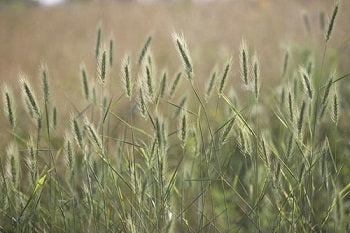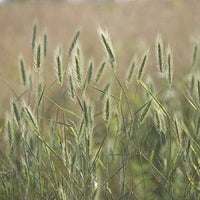
- When to plant:
- Spring, Summer
- Fertilizer:
- Varies
- Seeding rate:
- 20 - 30 lbs. per acre
- Seeding depth:
- 1/8 - 1/4 inch
- Ideal ph:
- 5.5 - 7.0
- Gmo:
- No
- Inoculant needed:
- No
- Coated or raw:
- Raw
- Lifecycle:
- Perennial
- Climate zones:
- Transition Zone, Warm Season
Virginia Wildrye is a cool-season, perennial bunchgrass native to North America. Virginia Wildrye typically forms clumps with slender stems that can grow anywhere from 2 to 5 feet tall. The grass features long, flat, and coarse leaves. Similar to other wildrye species, Virginia Wildrye produces distinctive, nodding seed heads. These spikes contain seeds with long awns, which give them a unique appearance.
Product Information
- Botanic Name: Elymus virginicus
- Application or Use: Pasture, Forage, Cover Crop, Habitat
- Germination Time: 7 - 14 days, under optimal conditions. Allow 3-4 weeks for the unstratified seed to break dormancy and germinate, under optimal conditions.
- Growing Locations: Warm Season, Transition Zone, Cool Season
- Height: 2 - 4 feet
- Sunlight Requirements: 8+ hours, full sun for best results
- Advantages: Adapted to many soil types; excellent forage and habitat species
- When to Plant: Recommended planting time is spring and summer when night time temperatures are consistently 65+ degrees.
Product Information
Virginia Wildrye thrives in various soil types, including clay, loam, and rocky soils, and can tolerate both dry and moist conditions. It prefers full sun to partial shade. This grass is commonly used for erosion control, soil stabilization, habitat restoration, and in reclamation projects. Its deep root system helps prevent soil erosion, making it valuable in areas susceptible to erosion.
Virginia Wildrye provides cover and food for wildlife, particularly birds and small mammals. It can be an essential component in restoring and maintaining natural ecosystems. Once established, Virginia Wildrye is relatively low-maintenance. Regular watering during establishment can aid growth, but it's otherwise drought-tolerant. Mowing or cutting back in late winter or early spring can promote new growth.
Virginia Wildrye is valued for its ability to stabilize soils, its wildlife benefits, and its adaptability to various soil conditions, making it a practical choice for erosion control and ecological restoration projects, similar to other wildrye species.
*Product packaging may appear different than what is pictured.
When choosing to start a new lawn, remove old vegetation by using a de-thatcher, power rake or tiller to kill the existing vegetation. Rake or drag the area to remove debris and dead grass for a clean area. Ensure the soil is leveled and loosened to allow the seed to have good soil contact once spread on a clean seed bed.
If you have an area with heavy weed coverage, we recommend starting fresh by killing and removing the existing vegetation. If you choose to use chemicals, herbicides or fertilizers, you must check with the product's manufacturer prior to planting new seed to ensure the proper waiting period.
When overseeding an existing area, mow your lawn at the lowest setting and bag the clippingsx. Rake or drag any areas that have dead thatch or debris.

Seed Quality
Hancock Seed is dedicated to delivering the best seeds possible to our customers. Hancock Seed grows and harvests many of our products, and we acquire the majority of the rest from other family farmers.
All these seeds are processed, packaged and shipped from Hancock Farm. This helps us ensure that our high standards are met. Unlike much of the competition, we refuse to sell you a seed that was not gathered during the last harvest. You will always receive fresh product from Hancock.
Every seed we grow comes with 40 years of experience behind it...you can rest assured that all of our products are cultivated in a method that assures its potential for growth.

Your cart ( 0 )

Virginia Wildrye is a cool-season, perennial bunchgrass native to North America. Virginia Wildrye typically forms clumps with slender stems that can grow anywhere from 2 to 5 feet tall. The grass features long, flat, and coarse leaves. Similar to other wildrye species, Virginia Wildrye produces distinctive, nodding seed heads. These spikes contain seeds with long awns, which give them a unique appearance.
Product Information
- Botanic Name: Elymus virginicus
- Application or Use: Pasture, Forage, Cover Crop, Habitat
- Germination Time: 7 - 14 days, under optimal conditions. Allow 3-4 weeks for the unstratified seed to break dormancy and germinate, under optimal conditions.
- Growing Locations: Warm Season, Transition Zone, Cool Season
- Height: 2 - 4 feet
- Sunlight Requirements: 8+ hours, full sun for best results
- Advantages: Adapted to many soil types; excellent forage and habitat species
- When to Plant: Recommended planting time is spring and summer when night time temperatures are consistently 65+ degrees.
Product Information
Virginia Wildrye thrives in various soil types, including clay, loam, and rocky soils, and can tolerate both dry and moist conditions. It prefers full sun to partial shade. This grass is commonly used for erosion control, soil stabilization, habitat restoration, and in reclamation projects. Its deep root system helps prevent soil erosion, making it valuable in areas susceptible to erosion.
Virginia Wildrye provides cover and food for wildlife, particularly birds and small mammals. It can be an essential component in restoring and maintaining natural ecosystems. Once established, Virginia Wildrye is relatively low-maintenance. Regular watering during establishment can aid growth, but it's otherwise drought-tolerant. Mowing or cutting back in late winter or early spring can promote new growth.
Virginia Wildrye is valued for its ability to stabilize soils, its wildlife benefits, and its adaptability to various soil conditions, making it a practical choice for erosion control and ecological restoration projects, similar to other wildrye species.
*Product packaging may appear different than what is pictured.
Instructions
When choosing to start a new lawn, remove old vegetation by using a de-thatcher, power rake or tiller to kill the existing vegetation. Rake or drag the area to remove debris and dead grass for a clean area. Ensure the soil is leveled and loosened to allow the seed to have good soil contact once spread on a clean seed bed.
If you have an area with heavy weed coverage, we recommend starting fresh by killing and removing the existing vegetation. If you choose to use chemicals, herbicides or fertilizers, you must check with the product's manufacturer prior to planting new seed to ensure the proper waiting period.
When overseeding an existing area, mow your lawn at the lowest setting and bag the clippingsx. Rake or drag any areas that have dead thatch or debris.
















